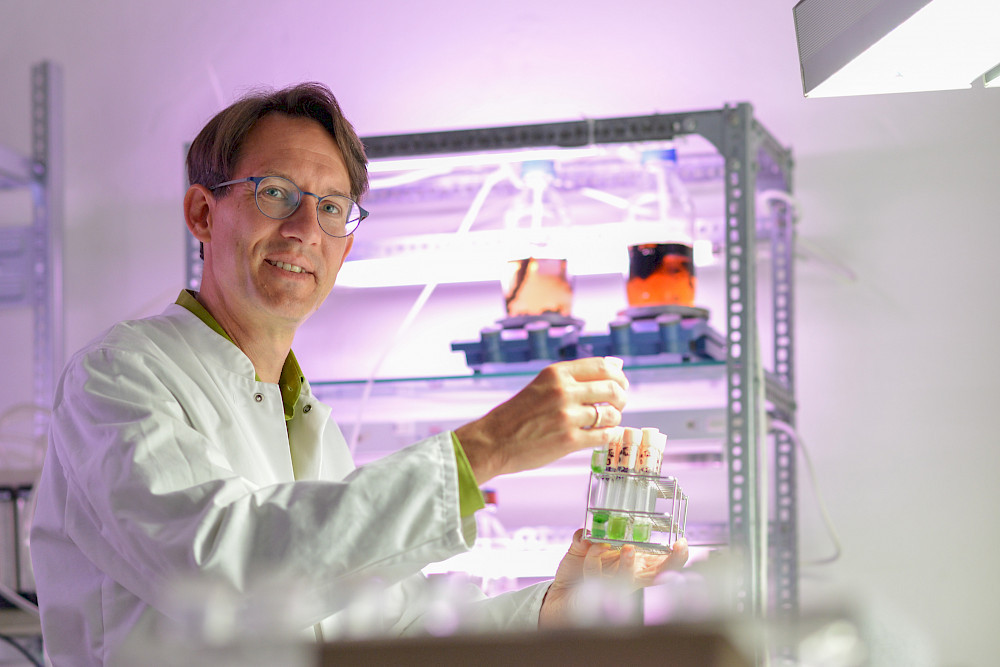Hunt for the eagle killer

It all started in the 1990s when bald eagles, the national symbol of the United States, began to mysteriously die. In the state of Arkansas, dozens of birds had lost control of their musculature, drooped their wings in an uneagle-like manner, toppled over and eventually died. The cause was traced to their brains, which were full of holes like Swiss cheese. “Where the disease came from was a mystery,” says Professor Timo Niedermeyer from the Institute of Pharmacy at MLU. It wasn’t until 25 years later that, with his help, the reason behind the eagles’ deaths was identified.
In the 1990s, other bird species were found to also suffer from the disease called “vacuolar myelopathy” (VM). It turned out that eagles were just the last link in the food chain. The predators fed on smaller birds and fish, which were also affected. “Our colleagues in the U.S. finally discovered an aquatic plant that appeared to be linked to VM,” says Niedermeyer. The neurological disease only occurred near lakes with Hydrilla verticillata, an aquatic plant that is invasive to the U.S.
Dr Susan Wilde, a professor of biology at the University of Georgia in Athens, made the first breakthrough in 2005. She discovered a novel cyanobacterium on the leaves of the hydrilla. Feeding experiments showed that the disease only occurred after plants infested with the bacteria were ingested. She named this new cyanobacterium Aetokthonos hydrillicola, “eagle killer that grows on hydrilla”. She speculated that a cyanotoxin must be causing the disease. In 2010, Timo Niedermeyer chanced upon reports on it. “I had just started working on cyanotoxins at the time,” recalls the pharmacist. The story fascinated him, so he contacted the American researcher. “She responded immediately saying that they still didn’t know what kind of toxin was causing the disease.”
Niedermeyer offered to help, so Wilde sent him samples of the infested water plant. “Because the plants grow very slowly, it took us an entire 18 months to grow enough pure culture of the bacteria for a feeding experiment,” says the researcher. He sent the bacterial culture back to the U.S., where Wilde conducted feeding experiments on chickens - but the results were negative. The neurological damage was not caused by the cyanobacteria alone. Niedermeyer and his team altered the cultivation conditions and created a faster-growing variant of the cyanobacteria. Again, they reached a dead end. “Not only was it driving the birds crazy, it was driving us crazy as well. We wanted to solve the puzzle at all costs,” he says. He was on the verge of giving up.
His move from the University of Tübingen to the University of Halle in 2017 represented a turning point. “We finally had a doctoral position for the project,” says Niedermeyer. But even more important was a special piece of equipment that he was able to purchase with funding from the DFG, the state and the university: a mass spectrometer. Using mass spectrometry imaging, Steffen Breinlinger, who wrote his dissertation on the subject, was able to examine the surface of the leaf - molecule by molecule - and finally stumbled upon a substance that only occurred where the bacteria grew.
“The structure is really quite spectacular,” says Breinlinger, because it contains five bromine atoms, unusual for a compound produced by bacteria living in fresh water. At the same time, the compound explained why the laboratory cultures did not produce the molecule. “They simply didn't have access to bromide,” says Niedermeyer; normal nutrient solutions don’t contain it. And indeed: when potassium bromide was added, they began to produce the compound. In feeding experiments, Wilde confirmed that the unusual natural substance triggers “vacuolar myelopathy”. The researchers named the toxin aetocthonotoxin, “eagle killer toxin”, in reference to the cyanobacteria.
The perpetrator and the murder weapon were finally identified. A Czech research group participating in the project conducted genome analyses and discovered the DNA segments responsible for the biosynthesis of the substance. The plant apparently provides the necessary bromide, which it absorbs and accumulates from deposits found at the bottom of the body of water.
The original source of the bromide remains unclear. Bromine compounds can occur naturally in rocks but are usually only released in small quantities. Suspected sources include coal-fired power plants, residues from the production of flame retardants that contain bromine, and one of the herbicides used to combat the invasive water plant. “Sometimes we don’t realize the consequences of what we are doing to the environment,” says Niedermeyer. Controlling the aquatic plant and the cyanobacterium will be difficult as they have spread throughout the American Southeast.
For Timo Niedermeyer, the case is an example of how persevering in an exciting project can pay off. The study, which he published together with Susan Wilde and other partners, became the cover story of “Science”. “The response to the article was quite overwhelming and somehow satisfying after ten years of putting a lot of heart and soul into it,” says Niedermeyer. Various national and international media outlets picked up the story, from Deutschlandfunk to FAZ, the US magazine “The Atlantic” and the technology magazine “Wired”. Niedermeyer wants to conduct further research on the toxin aetocthontoxin as well as the cyanobacterium. Among other things, it is still unclear whether mammals can also be affected and whether eating fish from affected lakes can be dangerous.
Prof. Dr. Timo Niedermeyer
Institute of Pharmacy
Telephone: +49 345 55-25765
E-Mail: timo.niedermeyer@pharmazie.uni-halle.de
